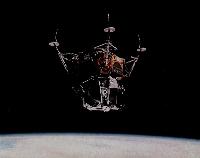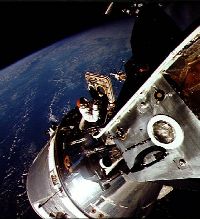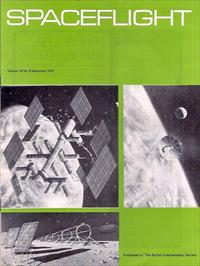The Space Programme
by Martin Willey
Thanks to Marcus Lindroos
The space programme in 1999 is very advanced, with a large Moonbase with a population of scientists from around the world, an interplanetary space dock (Breakaway & Dragon's Domain), and missions to the planets (Jupiter in Matter Of Life And Death, Uranus in Death's Other Dominion, Ultra in Dragon's Domain, Meta in Breakaway, a Venus space station in The Exiles & The Lambda Factor). There have even been interstellar missions: the unmanned Voyager craft in 1985 (Voyager's Return) and a manned mission the same year as Cellini's mission (Brian The Brain, although poorly publicised or secret so that the Alphans don't remember it).
In Journey To Where the first man in space is the Russian Yuri Gagarin, followed by the American Alan Shepard on May 5th 1961. While Shepard was married to Louise, the episode claims Gagarin was unmarried: in reality he had been married for 4 years by the time of his flight on 12th April 1961.
In The Last Sunset, Koenig and Victor inspect photos of the Moon taken by the Lunar Orbiter missions of 1966-67.
An unpainted model of an Apollo Saturn V rocket is seen in Bergman's living quarters in several episodes (Matter Of Life And Death, Black Sun, Ring Around The Moon, Alpha Child). Baxter's room in End Of Eternity has photographic prints of David Scott leaving the Apollo 9 Command Module for an EVA (6th March 1969) and the Apollo 9 Lunar Module "Spider" in lunar landing configuration (7th March 1969). These also appear on the lab walls in Dragon's Domain.
In Ring Around The Moon, a small photo of Skylab can be seen on Victor's noticeboard, taken from the departing Skylab 2's final fly-around inspection on June 22 1973. The single solar panel and parasol solar shield, rigged to replace the missing micro-meteoroid shield (damaged during launch), can be seen.
Apollo 9 images used in End Of Eternity and Dragon's Domain, Skylab photo used in Ring Around The Moon (photos copyright NASA)




In The Taybor, Sarah Bullen is reading the magazine Spaceflight, the magazine of the British Interplanetary Society. The monthly magazine was first published in 1956, one year before Sputnik, and is still being published. The issue is Volume 16, No.9, dated September 1974 (thanks Jorge Carmo).
The three paintings, by Rick Sternbach with G. Harry Stein, accompany Dr R C Parkinson's article "Take Off Point for a Lunar Colony". and Stein's article "The Third Industrial Revolution: The Exploitation of the Space Environment", about using raw materials on the Moon and nearby space. Top left is a "space factory" complex in Earth orbit. Right is the re-entry of a "space box car" using the Avco drag-brake concept. Below is a lunar electromagnetic catapult firing cargo into space.
Many new manned space vehicle development projects were started in the 1970s as the Apollo project started to wind down. By 1986, Moonbase Alpha had already been set up and a manned expedition was under-way to Uranus (Death's Other Dominion) while the first unmanned Voyager interstellar probes had been launched (Voyager's Return). "Space stations" on or near Venus (The Exiles, The Lambda Factor) and presumably Mars were being set up when Koenig was a space cadet. The rate of progress is staggering and must have required higher funding levels than even those of the Apollo project in the 1960s. Obviously the manned space programme is regarded as extremely important by the major nation states on Earth, the most logical reason being military needs/national security.
In Gerry Anderson's earlier TV series UFO, first contact with visitors from a hostile extraterrestrial civilisation is established in the early 1970s which prompts the creation of a vast military space infrastructure to defend Earth. Of course, UFO:1999 was initially envisioned as a direct successor to UFO and, even in its final incarnation as Space:1999, does not directly contradict its predecessor. According to the Writer's Guide, "Some years back, the major powers on Earth, having determined that life exists outside our solar system, have united and created a manned, permanent base on the moon, with the purpose of maintaining surveillance of deep space, and of becoming the first 'early warning' outpost of Earth's defence system." The dialogue in Dragon's Domain strongly suggests life in space (even intelligent space-faring extraterrestrials) and other strange phenomena had already been detected, despite questions about the veracity of Tony Cellini's testimony about finding alien life near planet Ultra in 1996.
Extraterrestrial know-how would seem to be the logical source for antigravity and antimatter; two highly advanced "breakthrough" technologies which by the mid-1980s apparently had opened up the entire solar system to manned exploration. The Eagle Transporter clearly utilises antigravity since it carries neither propellant tanks nor thermal protection heatshields for landing on Earth-type planets having a comparatively high gravity and dense atmosphere. The Alphans also have the ability to control gravity inside Moonbase Alpha (see e.g. Black Sun, Space Brain) as well as inside spacecraft. Antimatter is used experimentally in Space Brain, and probably can be used as a powerful bomb capable of single-handedly devastating an entire planet (The Metamorph). A recurring theme (particularly in early episodes such as Breakway, Voyager's Return and Death's Other Dominion) is the negative impact of scientific experiments gone awry.
The Rules of Luton refers to the "global and awful" "war to end all wars" of 1987. Koenig mentions that the survivors realised they had to "work together, accept each other for what they were" as they began to create a "brand new, wonderful civilization" which erased tribal prejudices between "races, classes and religions".
Presumably, leading up to the conflict there were escalating military research budgets (continuing the real-life "space race" between the USA and Soviet Union of the 1960s, and concepts like the 1983 "Strategic Defence Initiative" technology programmes). The Hawk, a space based fighter seen in War Games, may have been developed at this time.
After the conflict, we presume that nations pooled their resources and reallocated military budgets to shared projects in order to forge diplomatic and political alliances. The real life space programme has also increasingly moved to multi-national projects, after the Apollo-Soyuz Test Project (1975), notably the International Space Station (since 1998).
In space, Moonbase Alpha and the space programme infrastructure apparently survived the cataclysm well enough to support continued missions to other planets (e.g. Astro 7 mission to Jupiter in 1994, Ultra and Swift "star" missions in 1996, Meta in 1999).
The unified Earth space programme is now supervised by the World Space Commission which is funded by the International Lunar Finance Committee (see Organisations section below). Perhaps the main reason for the Moonbase and the space programme funding is revealed by Simmonds in Breakaway: "Atomic waste disposal is one of the biggest problems of our time." The busy nuclear disposal areas indicate the demand for radioactive waste disposal away from Earth. In the script of The Seance Spectre Koenig states waste was stored on the Moon since the 1980s. The Space:1999 Year Two Official Handbook states that in 1988, Nuclear Reactors became the major source of power for the world and consequently the radioactive waste had to be safely disposed of. The best method devised was to transport the waste to the dark side of the moon and bury it deep in rock.
By the late 1990s, human space exploration has reached the edge of our solar system but is apparently plagued by insufficient funding and poor political support. There is clearly a cause/effect correlation between this and numerous mission failures (Dragon's Domain: "there's nothing like failure for drying up the money supply."; Breakaway: "if one word, one hint, of failure leaks out, [the International Lunar Finance Committee will] immediately abandon their support for our whole [Meta probe] project"), but it is not clear if space budgets are cut because projects fail or if lacklustre funding is causing accidents... It seems almost no new spacecraft enter service after the mid-1980s since all spaceships seen in the series -- including the Eagle Transporter -- utilise the same basic crew support computers/avionics as Voyager One and the Uranus probe from 1985/86 (there have been no modernisation upgrades either). In Dragon's Domain, Koenig even exclaims that the alien spaceships discovered near Ultra "could save the space program billions of dollars and hundreds of years" while Cellini states the alien spacecraft "could make the dream of interstellar travel a reality. We could be liberated from our own solar system." Commissioner Dixon laments, "the reality of space adventuring is that it's terribly expensive. The chances come infrequently and then only one at a time."
According to Breakaway and Dragon's Domain, the international space programme is co-ordinated by the World Space Commission. Commissioner Simmonds and his predecessor Dixon seem to be in direct charge of Moonbase Alpha and space missions, although their proposals have to be ratified by the Space Commission. Funding for the base and space probes comes from the International Lunar Finance Committee, mentioned in Breakaway. In Dragon's Domain Helena is writing a report to the Medical Authority of the World Space Commission. In Voyager's Return Victor claims to speak as the voice of "Earth Space Authority" and "Earth Space Control".
The headquarters of the space programme remain in the USA. In Dragon's Domain, the Space News broadcast comes from Houston. In The Bringers Of Wonder part 2, there is a spacecraft landing facility in the middle of New York.
There seems to be far fewer American and Asian astronauts on Moonbase Alpha than one would expect. Possibly those regions were hit particularly hard by the war of 1987 (in The Rules of Luton Koenig reveals his wife was a casualty of the war). On the other hand, Europe in general and Britain in particular seem to have fared better as most Alphans apparently come from Britain and Europe. The Old World bloc of nations presumably contributes the lions share of the funding in 1999, although the U.S. possibly remains the single largest contributor.
According to War Games, Koenig is the ninth commander of Moonbase Alpha. His immediate predecessor, seen in Breakaway, was Commander Anton Gorski, who in Dragon's Domain is named as being commander in 1996. It seems likely that there were other commanders in the intervening period between Gorski's appointments, rather than holding the post for four years continuously.
Copyright Martin Willey